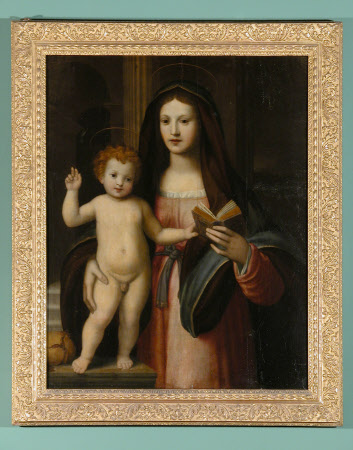Madonna and Child with a Pomegranate
Italian (Florentine) School
Category
Art / Oil paintings
Date
1500 - 1599
Materials
Oil on panel
Measurements
1022 x 832 (40 1/2 x 32 3/4 in)
Place of origin
Florence
Order this imageCollection
Stourhead, Wiltshire
NT 732113
Caption
The large split pomegranate on the plinth, with its hard case and a multitude of blood-red seeds, refers to Christ’s resurrection and unity of faith. Its presence became popular in fifteenth-century Florentine painting. Its symbolism of immortality or regeneration is related to the mythological story of Proserpine, daughter of the corn-goddess Ceres, who was abducted to the Underworld by Pluto. But, after she had eaten some pomegranate seeds, he allowed her to return to earth in springtime, so plants blossomed. In Jerusalem the pillars of Temple of Solomon (a biblical King prefiguring Christ) and the robes of its High Priest were decorated with pomegranates. They are mentioned in Solomon’s Song of Songs and became a metaphor of the Virgin’s chastity. Here the Virgin and Child stand in a classical building and she holds a book, possibly alluding to the Roman Missal 1472, which contains a reference to the feast day of her presentation at the temple.
Summary
Oil painting on panel, Madonna and Child with a Pomegranate, Italian (Florentine) School, possibly Giovanni Antonio Sogliani (Florence 1492–Florence 1544), previously attributed to Andrea Piccinelli, called Il Brescianino (fl. 1507 - 1525), 16th century. The Madonna stands three-quarter length in a classical interior with a view onto a landscape behind her, on the right. She is wearing a red robe and blue mantle and holds a missal in her left hand while her right hand supports the red-haired Infant Jesus Christ who stands on a plinth on the left. His right arm is raised in the act of blessing and there is a large pomegranate on the plinth behind his right foot.
Provenance
Acquired by Henry II Hoare (1705-85) as Palma Vecchio and thence by descent; given to the National Trust along with the house, its grounds, and the rest of contents by Sir Henry Hugh Arthur Hoare, 6th Bt (1865 – 1947) in 1946.
Credit line
Stourhead, The Hoare Collection (National Trust)
Marks and inscriptions
Verso: Inscription on back of panel and frame in white paint: 147 Verso: On back of panel and frame in red wax: mantled shield with three (?) balls/pomengranates(?) in chief, over ? ermine/spread eagle?
Makers and roles
Italian (Florentine) School, artist possibly Giovanni Antonio Sogliani (Florence 1492–Florence 1544) , artist previously catalogued as attributed to Andrea Piccinelli, called Il Brescianino (fl.1507 – 1525) , artist previously catalogued as attributed to Jacopo Palma Negreti, known as Palma Vecchio (Lombardy c.1479 – Venice 1528), artist
References
Colt Hoare 1818 Sir Richard Colt Hoare, A Description of the House and Gardens at Stourhead...with a Catalogue of the Pictures, Salisbury 1800, Bath 1818, rev. 1822, no.16 Stourhead 1838: Inventory of Heir-Looms at Stourhead directed to be taken by the Will of the late Sir Richard Colt Hoare Bart. with the state and condition thereof, 1838 , no. 340

